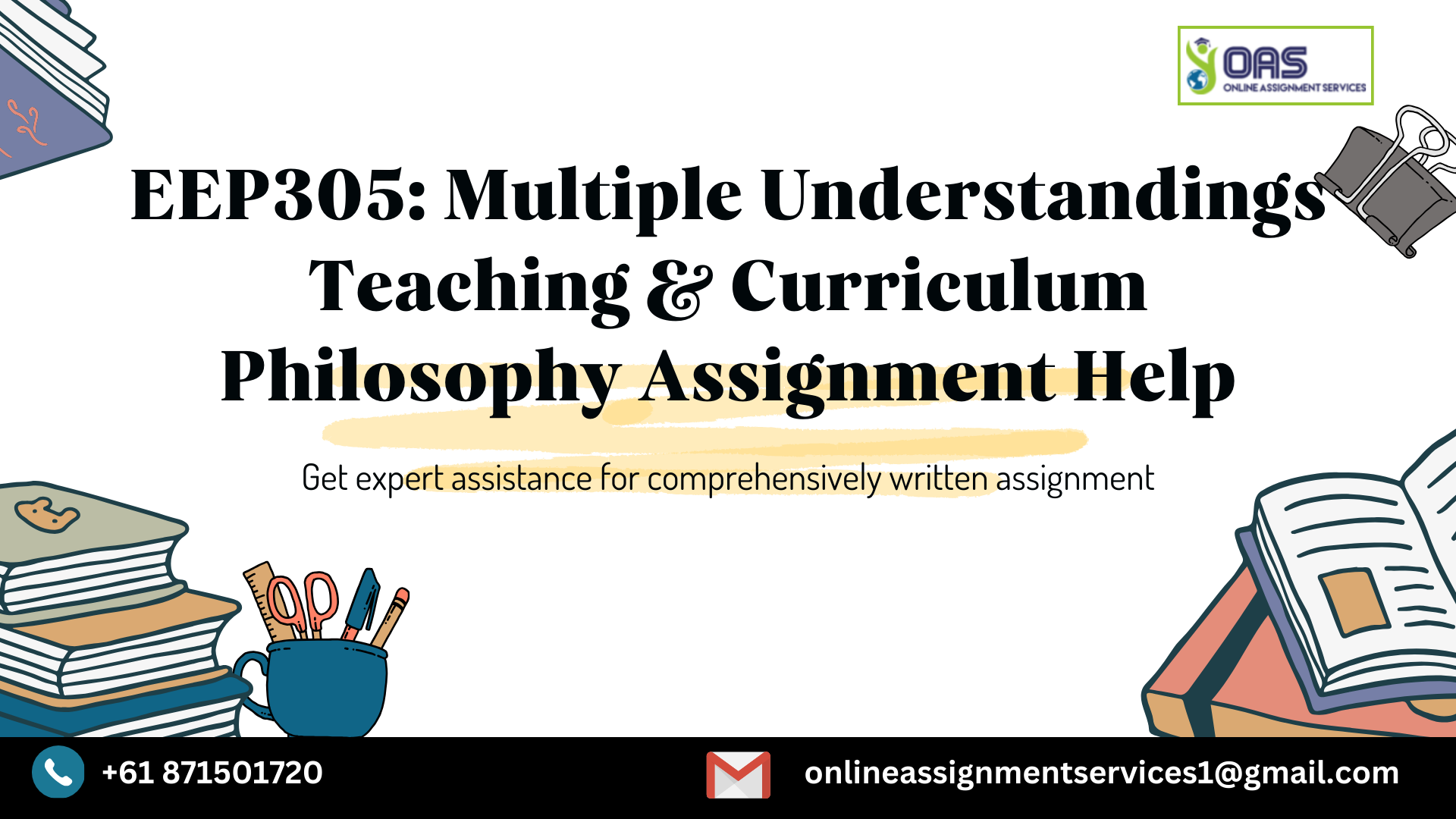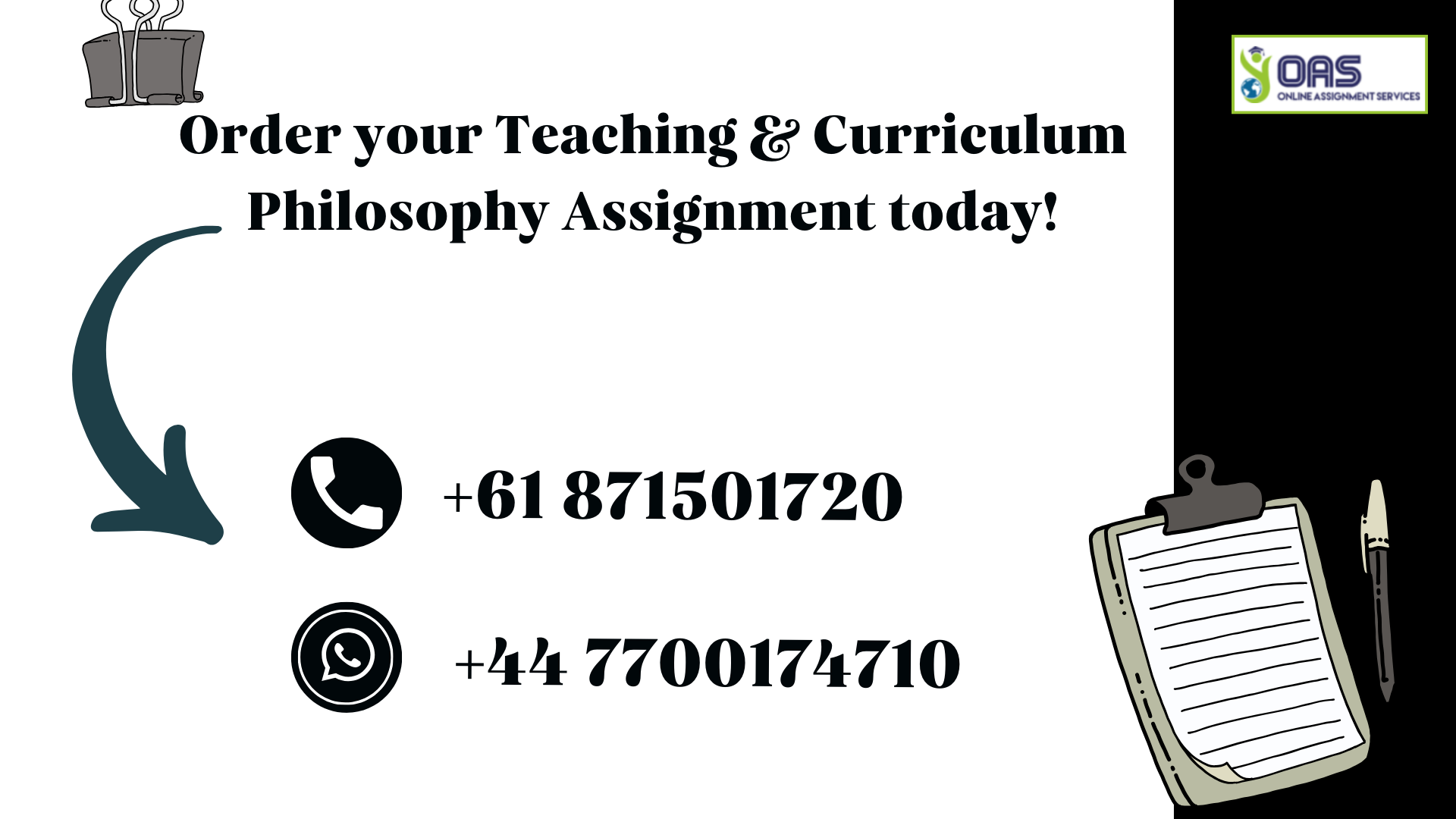EEP305: Multiple Understandings Teaching & Curriculum Philosophy Assignment Help

Question
EEP305: This assignment constitutes an important requirement for the Multiple Understandings course at Charles Sturt University. This assessment provides the student with an opportunity to outline their teaching philosophy while allowing them to evaluate and critically think about the different pedagogical theories one is related to, as well as the ideas that guide the student’s professional practice. This assignment comprises two parts- Part A, where the student is supposed to write a position statement outlining their approach to early childhood education and the curriculum they use. In Part B, the student demands the student to examine a case scenario, based on which a follow-up learning experience needs to be proposed by the student.
Solution
This assessment demands the student to thoroughly examine critically the teaching and learning theories of the EYLF, the ways in which young children learn, and the social functions of early childhood education. This is why many students pursuing a Bachelor of Education at CSU need assignment help, and we take pride in making their assignment writing easier at affordable prices.
Part 1
In the first part of this assessment, our experts have written a strong position statement describing the student’s curriculum and early childhood education philosophy. Our experts ensure that these are in accordance with the student’s own professional experience and views, which is how we provide personalized assistance through Bachelor of Education Assignment Help to our students.
The early childhood education should be focused on providing a nurturing environment that celebrates every child’s unique development by creating a holistic learning atmosphere. Children are “active learners” and hence build their knowledge through play, meaningful interactions with peers and educators; and hands-on experience. This has been supported by the Cultural-historical curriculum philosophy (Mclachlan et al., 2018). This teaching and curriculum philosophy encompasses aspects of physical, social, emotional, and cognitive development that aim at holistic growth. Cultural-historical curriculum philosophy is rooted in the belief that learning and development have a strong association with cultural and social interactions that should be emphasized in teaching. The core belief of culturalhistorical curriculum and teaching philosophy is centered on the idea that learning in childhood cannot take place in an isolated setting. Even within the confines of a classroom, interaction with peers, educators, and their cultural learnings has an important interplay in the process (Dafermos, 2018). Grounded on Vygotsky’s concept of the Zone of Proximal Development (ZPD), the philosophy underscores the importance of educator-supported learning as opposed to independent learning. This concept highlights the concept of providing support for the child to explore their full potential (Rahmatirad, 2020). Eun (2019) study describes that other than the difference between independent and teacher-based learning, ZPD can also be defined to highlight the difference between understood and active knowledge. The study further clarifies that while understood knowledge is gained by formal instructions and corresponds to the scientific concept of Vygotsky’s theory. Active knowledge is a result of the informal interactions of an individual with the world around defining the spontaneous concept of Vygotsky’s theory. By aligning the teachings with this philosophy, educators can understand each child’s ZPD and tailor their guidance and support according to an individual’s needs. The teaching environment should provide play-based learning within which children can explore and foster their curiosity and enthusiasm for learning (Stetsenko, 2020). This has also been supported by the Poststructuralist approach which encourages open-ended exploration and inquiry-based learning, allowing children to construct their knowledge and question prevailing narratives. The theory highlights that children’s identities and understandings of the world are constructed through language and discourse.
We have provided only a small section of the complete solution written by our experts. If you are also stuck with your assignment and need Early Childhood Assignment help in Australia for yourself, let us assist you! Mail us at onlineassignmentservices1@gmail.com.
Part 2
The second part of this assessment presents an extensive evaluation of the case scenario provided in the assessment file. Our experts provide the best assignment writing services in Bathurst by critically analyzing the situation from a theoretical lens.
The case study revolves around Maya, a four-year-old girl who is new to Australia, and after facing gender bias at preschool when told girls can’t be superheroes seeks comfort from her teacher.
Based on analyzing this scenario, our experts have created an appropriate learning experience for follow-up for Maya. Using this and the teaching philosophy which was discussed in the above section, the following questions have been answered comprehensively by our experts:
Question 1
In this section, our experts have analyzed the situation presented in the case in light of the pedagogical and curriculum-based beliefs. In providing Charles Sturt University Assignments Help, our experts have supported this answer with references to the EYLF learning objectives and an overview of the scenario’s key elements.
In this scenario involving Maya, a four-year-old child from India attending a preschool in regional NSW and is just beginning to learn English, the importance of culture, history, and social interaction in child development and learning can be evaluated as directed by Cultural-historical teaching (Fleer & Veresov, 2018). In this case study, Maya’s desire to be a superhero aligns with EYLF outcome 1 of a sense of identity in children and outcome 3 of a sense of well-being in children. As emphasized by Vygotsky’s theory, Maya’s interaction with John and Eli in the dress-up corner is a crucial form of social interaction that aids in cognitive development. John and Eli’s comments reveal stereotypes and gender biases influenced by their cultures. Looking at the brighter side, these comments provide a chance to identify the ZPD of the individual and suggest scaffolding interventions by the teacher, as suggested by Vygotsky’s Socio-cultural theory (Hedges & Cooper, 2018). The concept of ZPD, which defines the difference between an individual and a knowledgeable personsupported learning, relies heavily on the understanding of the educator. Maya’s ZPD is identified by her initiative of tying the cape and interacting with John and Eli. She lacks the knowledge and language skills to express and support her desire to become a “superhero” hence has a difficult time confessing the same to her peers. The teacher’s role is to identify this ZPD and provide appropriate support (Hedges & Cooper, 2018). Since Maya originally belonged to India, it is important to incorporate cultural and socially appropriate teachings as guided by the Cultural-historical philosophy.
We provide the Best assignment writing services in Bathurst. Get Bachelor of Education Assignment Help from OAS experts today! WhatsApp us at +447700174710 to get in touch with our subject matter experts.
Question 2
The following section presents further information that will be needed by an early childhood educator based on the respective philosophy of teaching and curriculum. Here, we have provided a snippet of the complete solution written by our experts:
As guided by the Cultural-historical curriculum philosophy, it is important to analyze the aspects of culture, family, community, and prior educational background to critically evaluate the situation. Further, the interplay of language and peer interactions as mentioned by Vygotsky’s theory, will help in comprehensively understanding the situation (Fleer & Veresov, 2018). Firstly, it’s crucial to gather information about Maya’s family background, particularly regarding their cultural practices, beliefs, and values. Understanding her family’s cultural context will enable educators to respect and integrate these aspects into her learning experience (Bennett et al., 2018). Assessing Maya’s level of English proficiency is vital. This includes understanding her current language abilities, any previous exposure to English, and her comfort level in using the language. This information helps in tailoring language support accordingly. It is also important to evaluate Maya’s prior educational experiences, both in India and in her new environment in NSW. This information can shed light on her learning trajectory and any potential challenges she might be facing in adapting to a new educational system (Essa & Burnham, 2019).
This is only a snippet of the complete essay. If you are looking for Early Childhood Assignment help in Australia for yourself, let us assist you! Mail us at onlineassignmentservices1@gmail.com.

Question 3
Here, a follow-up learning activity that could be planned for Maya and the other kids has been outlined by our experts based on the analysis of the situation. Our experts have also provided justifications from evidence-based articles on why this experience is appropriate.
A follow-up learning experience that could be prepared for Maya and the other children, is a “Superhero Day.” The experience will include children dressing up as their favourite superhero for a day. This experience is designed to promote inclusivity, challenge stereotypes, and scaffold language development while incorporating elements of Maya’s cultural background. This experience acknowledges Maya’s desire to be a superhero while fostering a sense of identity and belonging for all children (Wohlwend, 2015). It communicates that anyone can be a superhero, regardless of gender or cultural background, and helps in negating gender biases expressed by children in the scenario. The experience can incorporate elements of storytelling which will encourage diversity and help children understand different cultural perspectives. These activities suggested for the experience align with cultural-historical teaching by recognizing the significance of culture, social interaction, and individual development in early childhood education, ultimately fostering a more inclusive and enriching educational experience for Maya and her peers (Cremin et al., 2016).
Get Bachelor of Education Assignment Help from highly skilled subject matter experts at discounted prices! Give us a call at +61 871501720 to get better assistance from our experts.
Question 4
In the following section, our experts have described the methods for documentation and observation that the student would employ as an early childhood educator during the learning experience. We have provided half of the complete solution written by our experts below:
Following “Superhero Day”, educators can reflect on the children’s participation, language development, and interactions to inform future curriculum planning, aligning with the continuous improvement aspect of curriculum philosophy. By documenting and recording a social activity, the experience can be exposed to open discussion, reflection, meaningmaking, and the scope of future improvement (Rintakorpi, 2016). Since the Culturalhistorical curriculum philosophy emphasizes the need to encourage socio-cultural interactions and the need to incorporate culturally appropriate care, it would be important to observe such interactions in Maya’s context. Actively participating in the activities alongside Maya allows participant observation regarding her social interactions, peer collaboration, and how she negotiates and co-constructs knowledge about superheroes and diversity (Clark et al., 2014). As Vygotsky’s theory also suggests that understanding an individual’s ZPD will help in providing tailored scaffolding techniques, participant observation will also help in identifying Maya’s ZPD.
Get Multiple Understandings Assignment help in Australia at affordable prices. Please feel free to WhatsApp us at +447700174710.
Question 5
Lastly, our experts have elaborated on the learnings from the multiple perspectives in the early childhood curriculum. Our experts have also elaborated on how these learnings will be incorporated by the students in their practice as early childhood educators.
The multiple perspectives in the early childhood curriculum explain a well-rounded understanding of diverse educational philosophies and theories that are crucial for effective and inclusive teaching practices. The curriculum’s “no one-size-fits-all” approach to early childhood education advocates for the need to incorporate various learning theories in teaching. Drawing learnings from multiple theories like Socio-cultural approaches, Developmental approaches, and; Critical and post-structural approaches to early childhood curriculum offers unique insights into child development and learning (Elango et al., 2015).
Are you pursuing a Bachelor of Education at Charles Sturt University and need assignment help? Reach out to us at onlineassignmentservices1@gmail.com.

If you are looking for other assignments for the EEP305 Multiple Understandings course, you can check out other assignments written by our experts as well:
